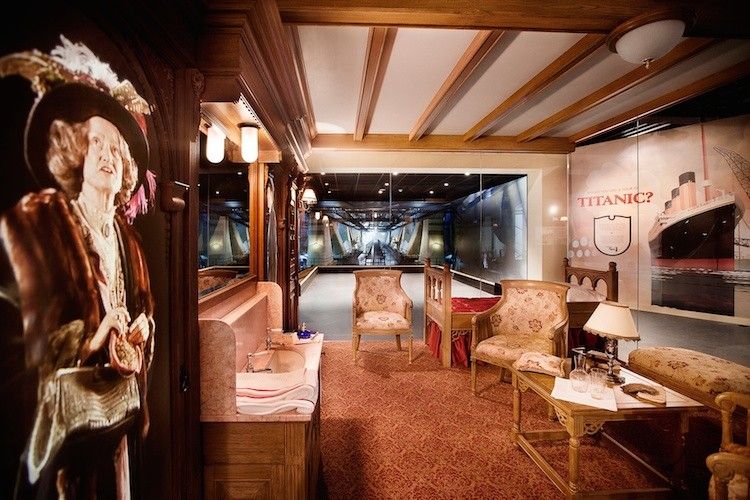
Once considered the less sophisticated cousin of Dublin, Belfast is now beginning to eclipse its larger neighbor to the south, and is emerging as a top tourist destination. One of the main reasons for Belfast’s recent resurgence in visitor popularity is the Titanic, a product of the city’s historic Harland and Wolff Shipyard.

Spending tens of millions of euro, a special area known as the Titanic Quarter on the large expanse of land of where the ship stood, has been re-developed into a series of museums that pay homage to the luxurious and tragic ship.

And this month, the area celebrates several major anniversaries. The main museum, known as the Titanic Experience, and boasting more than 1.5 million visitors so far, celebrates its second year of operation. The 150,700-square-foot venue accommodates nine galleries of interactive exhibition space, including a dark ride, underwater exploration theatre, recreations of the ship’s decks and cabins, and a luxurious conference and banqueting suite with capacity for up to one thousand guests. The building was constructed by Harcourt Developments, which together with Belfast Harbour Commissioners are the developers of Titanic Quarter.

A new discovery tour opened several weeks ago by which visitors wear special earphones, accompany a guide on a walking tour encompassing the drawing rooms where the huge ship was designed by Thomas Andrews and his colleagues, as well as the exact spot upon which it rested while being built. In addition, the nearby Titanic Dock & Pump-House where the ship was outfitted, was opened exactly a year ago, as was the SS Nomadic, a large tender boat that brought passengers out to the approximately 882-foot-long Titanic as it lay offshore.

The main museum, whose exhibits take between two and four hours to view, is a striking architectural accomplishment. Shaped like the bows of a ship and influenced by several other maritime themes including water crystals and the insignia of the White Star Line, the multi-story structure grants one insights into the ship’s construction and its tragic sinking on its maiden voyage across the Atlantic. This is all achieved through multi-media presentations, both video and photographic, depicting life in Belfast at the turn of the 20th century and through the various stages of planning and building of what was lauded as “the world’s largest man-made moving object.”

An elevator takes you up to an upper floor to indicate the sheer height of the vessel and a seated ride takes you down into a replica of the belly of the ship, where visitors watch videos of riveters, fitters and other specialists at work. Revolving color slides grant dramatic glimpses inside the ship from the belly where stokers shoveled coal into fires to feed the engine, and upwards into third, second and finally first-class compartments—all the way to the top of the ship’s mast. There are also exact replicas of rooms in each of the various classes. The most dramatic aspect of the museum, however, is its depiction of the actual sinking of the vessel, with recorded voices of survivors telling what happened. It gives patrons an idea of what it must have been like to have been onboard as it slowly slid down into its watery grave.

Telegraphed distress calls from the Titanic and messages among ships in the area are also shown, as well as information focusing on the ensuing investigations into what became the world’s third worst non-military marine disaster. Those involved in the arts will be attracted to the room devoted to literary and cinematic depictions of the tragedy that killed more than 1,500 people.

The informative walking tour of the SS Nomadic is made even more enjoyable through the use of talking models on screens, such as the bartender in the first-class compartment and the coal fire stoker. The tender went through several lives after the Titanic’s sinking, becoming a minesweeper, a troop carrier and a tug-boat before being purchased in Paris, transported to Belfast and renovated.

The Dock & Pump-House in the Northern Ireland Science Park, a 15-minute walk from the main museum, is impressive in its authenticity. There, visitors walk through the vast, ghost-like engine room housing the huge pumps (now partially rusted), that drained 21 million gallons of water (equivalent to 172 full-length swimming pools) from the dock in 100 minutes. Guests can also walk out onto the approximately 885-foot-long, 42-foot-deep dry dock itself, where the Titanic stood while being fitted with complex equipment. The structure took seven years to build, opened in 1911 and operated until 2001.

But not all of the Titanic Quarter is devoted to the ship and its history. Titanic Studios, a large warehouse and growing hub for film-making, is located behind the main museum. Here much of HBO’s Game of Thrones is being shot, as is a Dracula movie. In an effort to further diversify activities in the area, investors and tourism officials also built the multi-purpose Odyssey Arena complex, which includes an indoor section, a 12-screen multiplex cinema and a pavilion of bars and restaurants. With seating for 10,000, the arena hosts performances and sporting events, and is also home to the city’s professional ice hockey team, the Belfast Giants, which recently won the British Elite League.

There is little doubt that the Titanic Quarter has enhanced Belfast's tourism brand, and will continue to do so as the area itself expands, with plans to add even more attractions—and not all linked to the history of the ill-fated cruise ship.









